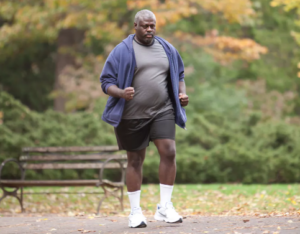
There is strong evidence that walking cuts the risk of developing prostate cancer, which kills about 30,000 U.S. men every year.
Walking is an undeniable way to lower the risk of prostate cancer.
A study of 90 men shows the importance of walking.
The study subjects had biopsies to see if they might have prostate cancer, and it turns out that the men who exercised on a regular basis were less likely to receive the alarming diagnosis.
This study showed that moderate level exercise was the key factor. This equates to at least three hours a week of brisk walking.
Such men were about 66 percent less likely than their non-exercising counterparts to be diagnosed with cancer of the prostate.
But there’s more. The men who had the prostate cancer were evaluated for exercise habits, and the men who reported that they engaged in just 60 minutes of walking per week, were actually less likely to have an aggressive form of the disease.
Why does exercise lower prostate cancer risk?
The researchers speculate that exercise lowers cancer prostate risk possibly because being active suppresses levels of hormones that help facilitate the growth of prostate cancer cells.
Another idea is that exercise boosts immune function.
Despite these findings, the researches emphasize that the study does not prove that prostate cancer risk is decreased with exercise.
The reason for this is because those who exercise tend to engage in other healthful behaviors such as avoiding smoking, and eating many fruits and vegetables.
These other healthy habits may contribute to a lower risk of prostate cancer, says the report, which appears in the online Journal of Urology.
The study showed prostate cancer in 79 of the men. Even though lifestyle-related variables were not factored into the study, other variables were adjusted for, such as body weight, age, race and other medical conditions.
More investigation is necessary into the association between walking and other exercise as they relate to lowering the risk of prostate cancer. Nevertheless, the results of this study are nothing to sneeze at.
Tips for Efficient Walking

Even if you’re very heavy and get winded easily, you can take up walking for exercise.
Walk for brief periods at a challenging pace. Then alternate that with a slow recovery pace. This is called interval training and makes the exercise more tolerable because it includes planned recovery periods.
An example would be a 15 second spurt of fast walking, alternating with a minute or two of slower walking.
If you use a treadmill, do not hold on other than to check your pulse, change the settings or drink water.
If you can’t keep up with the tread unless you’re holding on, this means that either the speed is too fast or the incline is too high.
Reduce the speed or incline so that you can move your body naturally as you walk, rather than hold on and disrupt natural gait. Holding on is not natural.
If you feel you’re going to fall off, you’re still going too fast. Slow down.
To lower the risk of prostate cancer, do not include walking that you’re already doing, such as on the job or during shopping trips.
Make it feel like exercise; get your heart rate and breathing elevated. Pump your arms.









































